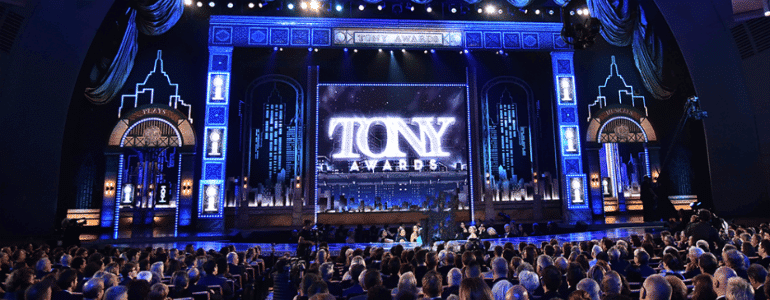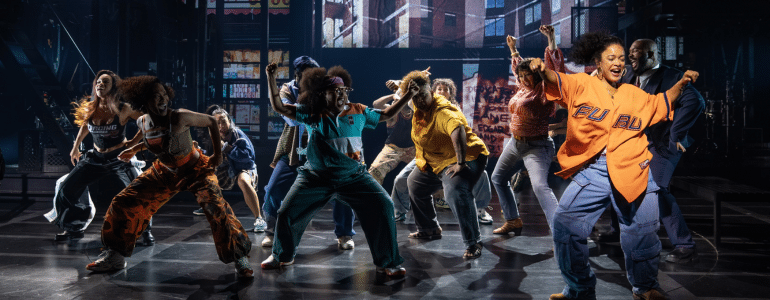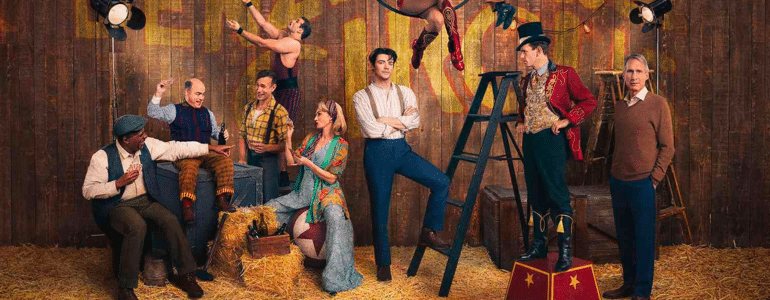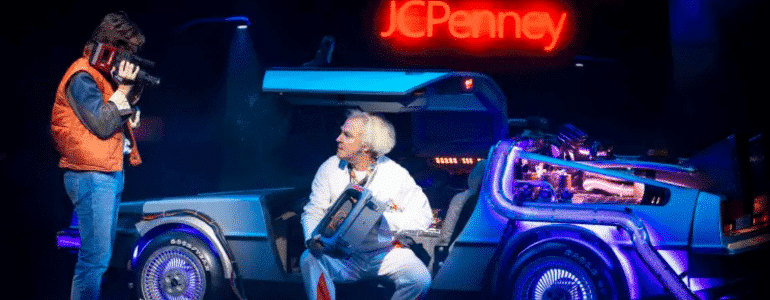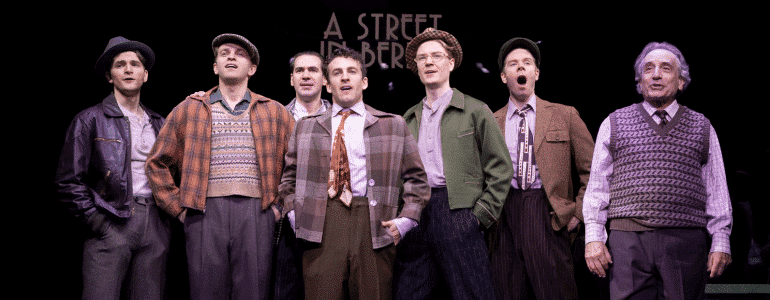Podcast Episode 29 Transcript – John Raymond Barker
Ken: Hey, everybody, it’s Ken Davenport. I wanted to make sure you heard the news that I’m bringing the Deaf West production of Spring Awakening to Broadway in the fall. If you love Spring Awakening, you wait until you see this production because you’ve never seen anything like it. Deaf West is one of the most innovative theater companies I have ever worked with and ever seen and their production of Spring Awakening is mind-blowing. Check it out . . . go to TicketMaster.com and get tickets. We start performances on September 7th. I’ve got a lot of work to do! Okay, on with the podcast!
Ken: Hello, everybody. Welcome back. I’m Ken Davenport. You’re listening to the Producer’s Perspective Podcast. We’ve got a very, very special guest this week on the podcast. You may not know his name, but you may have met him, especially if you’re a Kinky Boots fan. I want to introduce you all to John Barker, one of the ushers at the Hirschfeld Theatre. Welcome, John.
John: Hey there.
Ken: So let me give you a little backstory about why I invited John here. My first show that I produced was The Awesome 80’s Prom. Before I produced it, I had worked as a company manager and general manager for a ton of big time Broadway shows, Thoroughly Modern Millie and Gypsy and a whole bunch. When you work on a big Broadway show you have all of this infrastructure and these people between you and the customers. But when I went to work on the Prom I was the general manager, I was the group sales agent, I actually directed that. And, yes, I actually escorted people to their seats. And, even though I had worked on Broadway shows for about a decade before that, I swear to you I never learned more than when I was working on the Prom and that was because, for the first time in my career, I was on the front lines. I was actually talking to the consumer. I was hearing what their problems were, what their issues were, what it took to get them to purchase tickets and I learned so much that really defined who I am today as a producer. And ushers are so important to the Broadway community because they are on the front lines every single night. And John is here because he is one of the Jujamcyn Theater chain’s pride and joy. He came very highly recommended as one of their favorite ushers, so he graciously agreed to be on the podcast. So, John, tell me . . . how did this all start? How did you get the gig as an usher?
John: That is actually a great question. It is about who you know sometimes and I had been working in the Houston theater scene . . . the Alley Theatre, Theatre Under the Stars. I had done different things with them, but I did do some front of house work so it was a very logical connection to Jujamcyn through a sibling. Someone who used to be a manager at Jujamcyn, his sister recommended me and that helped me get right in. Basically this job was my first job in New York City. My first show to usher was Man of La Mancha, the revival, which was incredible. I spent the whole first year being amazed by the fact that I was being paid to sit there and watch the revival of Nine and Man of La Mancha, all of these great shows. To be paid to do this was incredible, because back in the regional scene, it can be a lot of volunteer work for people, but on Broadway it’s a paid union job. And it’s been my survival job off and on these past 12 years.
Ken: You’ve been doing it for 12 years?
John: Yeah.
Ken: Wow.
John: I also spent a little bit of time in there as a backstage doorman at the Walter Kerr Theatre, so that was a little bit of a middle part of my time. I was doing that steady for a while, and now I’m back to ushering and also subbing in on the door.
Ken: Have you always worked for Jujamcyn, the same theater chain?
John: That’s right, yeah. I’ve done a couple of shows with one of the other chains. I won’t name names. I might mention them later . . . but Jujamcyn has been my home all of this time.
Ken: A lot of people may not know this, but ushering is a union gig here on Broadway and also the same union reps the people that work at the stage door.
John: That’s correct and, funnily enough, movie theater projectionists. Not sure how that all fits together, but that is the way it’s broken down.
Ken: Of course, it makes perfect sense! Only New York unions. Okay, so when you started the job as an usher, was there a training period? How did it work? Were you just tossed out there and told, “Hey, show people to their seats?”
John: That’s a nice contrast to how things maybe are now and how things were back then. I kind of was thrown into it back then a little bit. I think they also, maybe, trusted that I knew what I was doing, based on my prior experience. I did have an interview with them so maybe they sensed that I knew enough to jump right in, but there wasn’t that much training back then. Now there is, and now there’s a lot of care taken to make sure that a new usher knows what to do, is walked through the theater, and all of those things. Any time you go to do a new show . . . if you’re subbing at another theater or what have you . . . is finding out all the specifics of that show and that theater and what’s going on. Anything to do with restrooms, where they’re located, to how long the show is, what are the late seating cues? So a big part of our job every day is helping those new people know what’s up, because it can be a little crazy, just jumping in, and everyone forgets, I think, sometimes, that new sub ushers need that help.
Ken: Do you wear uniforms at Jujamcyn?
John: We do.
Ken: Did you wear unfirms when you started?
John: Yes. They were less uniform-y. They were just black pants and a white dress shirt. They didn’t even have a set tie back then. I think we just had to wear a dark tie. And then it went into a phase where we had the Jujamcyn logo on the tie, it was a nice bright red tie. And then, just recently, they modified it to this really nice look, where we have these nice blazers with the Jujamcyn logo and we wear black dress shirts now and black ties and everyone looks a lot classier. Everyone’s a little bit sexier now, ushering on Broadway, because of this new look.
Ken: Jujamcyn is run by Jordan Roth. He’s a sexy guy.
John: Oh, absolutely.
Ken: So of course the uniform is sexy, I love it. And you like this change that’s happened over the last 12 years?
John: You know what? That is definitely something I’ve come to really respect about what they’ve done with the company. I may be incorrect about this, but my impression has been that Jujamcyn has been the first, at least of the for-profit houses, to revolutionize its customer service. I know that there is at least one other chain that’s not doing that and so, when I went back and ushered with them recently, I noticed that working with them felt like the way it used to be. It used to be that you could come into the theater and expect the usher might be grouchy, they might be really grumpy with you. That was sort of the way it was back then. When Jordan became president he slowly . . . which is a good thing, because you can’t do change too fast . . . he slowly started implementing all of these new ideas. And I think most of the ushers have bene pretty okay with it. I think sometimes people get grumpy about change, but the changes have been really for the better. Because I always found that when you come to work and are in a good mood and are nice to the patrons your day is easier, your job is easier, and now that’s the culture of where I work and so it’s a lot easier to work with other ushers and the patrons and with anyone else who’s working in the theater when we all have this understanding that we’re going to be treating each other . . . it sounds so silly to say it . . . but treating each other with respect and giving good customer service. And that’s something that has built over the years. Little things from . . . we have these trainings where we learn and talk about the challenges of being an usher and how do we address those challenges? What are our options? Should we be mean to the patron? Should we maybe be understanding and help them? And that’s been a process that, like I said, has made it a much happier place to work.
Ken: What do you like about being an usher? What about it really appeals to you and why do keep doing it? It’s been 12 years.
John: Well, personally, being completely selfish in the answer, it’s because it’s been one of the most flexible and beneficial survival jobs, in that it pays decently for what scheduling it is, and you’re around the Broadway scene so you’re getting to meet people and feel connected. And one of the things I like about being around a show for a long time is watching the actors work over a period of time, whether it’s watching Billy Porter for the last couple of years continue to grow and make that role even more special than he already had when he won the Tony. And then it’s also fun watching the understudies go in, and replacement actors go in and you can learn a lot just from observing that process. So I find the education in it. I do enjoy the people I work with, so that’s allowed me to be happy in the job. And I know that, at the end of the day, of all the jobs I could have, especially in the city, this is probably the least worthy of complaint. You can complain about any job, but this job . . . every time I complain about this job, I have to slap myself and say, “But, really, you could be standing behind a counter somewhere serving coffee or waiting tables, and you’re not.”
Ken: That’s a great tip for anyone out there that’s looking to get into the business. Just being around it and being able to observe it, you can learn a lot, no matter where you are. Whether you’re ushering, whether you’re at the stage door. If you could define what the responsibility of an usher was, what do you think the responsibility is? What would define an usher for you?
John: An usher is obviously responsible for getting the patrons to the right seat and giving them their Playbill. That’s sort of a basic for every patron. It’s being there to answer questions. Patrons have needs. They don’t know where things are. You do, so you have to be able to tell them, “The bathroom is over here.” “The coat check is over there.” “You can use the bar down here or upstairs.” Whatever it could possibly be. I think this is what Jujamcyn is trying to help us feel, is this sense of taking care of the patrons while they’re there, to be a host, to welcome them into our home and make them have a good time as if they’re at the party and you’re trying to take care of them. That’s the ideal, and so I do feel a bit of that when I’m with these people. I feel like they’re my guest sometimes, especially if I stay in that section throughout the show and I’m encountering them over and over again. I’m aware if this person needs a little more help getting to the restroom or this person is having a little difficulty with being comfortable in their seat of what have you. Then you’re aware of the situation and you can take care of them throughout the show. I mean, it’s not so much about being a regulator of the rules. It can be that, but that’s exactly what Jujamcyn is trying to change about it, is that it’s not about being the security or the enforcer of all of those things. You are doing that, but you’re also taking care of people.
Ken: What’s the biggest or most common question you get asked from customers?
John: “Where’s the restroom?” You get a whole gamut of things and you always hear the same things over and over again, the same terrible jokes about oxygen masks and nosebleeds in a theater that’s clearly not that big. I think that’s definitely one of the misconceptions people have, that if they have a seat at the highest end of the theater they’re going to make that joke. People want to know how long the show is. They want to know what time they’re getting out. They want to know if there’s an intermission. These are just such simple questions. But then people will ask you interesting questions. “How old is the theater?” I do know that, but I wish I knew more about the history of the theater because people get really excited about that. People want to know about the actors on the stage. Every day can be different and interesting, and then some days can be just routine. It’s the same questions. “Where’s the bathroom?” “Can I get a Playbill?” “Where’s my seat?” “Why is it so cold in here?” All of those things.
Ken: Do you hear complaints more often than not from people about their experience at the theater? Is there a common gripe that they have?
John: I think that the biggest complaints a patron would have is the fact that it’s so difficult to regulate the temperature of a Broadway theater. I don’t think people realize just how difficult that is to do, especially in the summer when we’re fighting extreme temperatures and we also have the stage full of hot lights. And the cast, they need a certain temperature or they’re going to be sweating all of that makeup and glitter and everything off. So they’ll be frustrated about the temperature and we just try to comfort them and let them know we’ll let the manager know. The engineer’s constantly trying to check the temperature with his little laser gun. That’s one of the big ones. The challenge we have at the Hirschfeld . . . and I love to let people know the history of why it is the way it is so that maybe they’re a little less upset about it . . . is the fact that the women’s restroom is in the basement and the men’s room is on the mezzanine level. So if you’re in the orchestra, it’s not that big of a deal. Everybody has to take a flight of stairs to get to the restroom. But if you’re in the mezzanine, the ladies have to go down two flights and the men, their bathroom is right there. What I tell them is, “Look, this theater is 90 years old. We don’t have an elevator for that reason, and when the theater was built” . . . this is the story that was told to me . . . “it was reversed. The ladies room was on the mezzanine level. The men’s room was in the basement with a smoking lounge. But because the percentage of women coming to the theater grew exponentially, they had to reverse it.” And apparently that happened in the ’80s. And the world was different back then. You didn’t have people drinking alcohol nonstop during the show and having to use the restroom, so the lines weren’t as tremendous. So that’s the big one. “It’s cold in here.” “Why is the women’s restroom two levels down and the men’s is right there?”
Ken: So sippy cups are the reason why the lines at the women’s restroom are so long.
John: They’re a blessing and a curse.
Ken: Those of you who heard the Tim Rice podcast, that was his biggest gripe about the theater, what was causing its downfall, so take a listen to that. Do you get a lot of international visitors over there?
John: We do with Kinky Boots. For some shows it varies, but Kinky Boots definitely does. And that’s something you have to assess quickly, because they’re not going to understand that you’re telling them to go three rows up and to the left, and they’re just going to wander off. And you have to keep an eye on that, especially now that we’re into that season and that’s become the new wave of our guests. You’ve got to watch out for that, and also the fact that they don’t understand all the rules, and if they don’t speak English, they’re not going to hear the preshow announcement. They’re not going to read the Playbill to see “Don’t take pictures” and stuff, and so understanding that is so important when you’re dealing with them.
Ken: Let’s talk about some of those rules. You mentioned the idea, the old-school idea, that an usher should be like a security guard in a way and actually a blog I wrote years ago, which I’ll put in the link to this podcast, was when I got so in trouble because I was taking a picture of the curtain call of Hair when it was in the Park. And an usher practically confiscated my camera, put his hand in my face . . . and I was so overwhelmed about it that I blogged about it. Has that changed? You are given specific rules on things that you need to make sure do not happen, right? Like what? What are you on patrol for?
John: That’s one of the biggest ones, and it’s the reason why it’s important for patrons to always ask questions when they enter the theater, because at our theater . . . at our show, I should say, because maybe the rule will change when another show comes in, way after Kinky Boots closes in 2050.
Ken: It’s never closing! Kinky Boots is never going to close.
John: That’s right. Kinky Boots is a show that, so smartly, is allowing patrons to take photos in the theater before intermission and after, and even of the curtain warmer. And that is so smart because that’s just easy advertising. It’s just great for people to be able to create those memories, and it’s one less thing for me to say, “No, don’t do that.” But during the show it’s a huge issue for a couple of reasons. Obviously copyright is a big issue that different people involved with the production are going to be concerned about people taking photos. Every photo that you can purchase is reviewed and it’s been authorized. But the other thing is, of course, if it’s a flash, that’s dangerous for the actors. So we are asked to patrol those kinds of things. Texting is the big one. When I first started ushering, phone ringing was the big issue. Now I feel like phones don’t ring as much, but they’re on and people are checking the time, which is a little bit less of an issue. But when they’re on there and they’re texting or doing whatever they’re doing . . . we know, famously, from our news of late, what a distraction it is. The actors do see these things, so we are asked to take it very seriously and patrol for those things. Different shows are a little bit more lenient about the curtain call but, really, no, if actors are on the stage, photographs should not be taken. So there is this challenge of people want to do this, they want to take photographs. Like I mentioned, in other countries they may be allowed to take photographs and those patrons don’t understand the preshow announcement and don’t realize that. So if you can be empathic about those kinds of things . . . that people are just excited or that people maybe didn’t understand or maybe they were late and they missed the announcement, or whatever it could possibly be . . . trying to do it in a kind way as much as possible is the way to go and that creates a better experience for yourself and the patron, because then you’re not having this ugly moment. That’s how I view that. But sometimes you’ve got to, unfortunately, wave that flashlight and get the attention of someone who’s smack in the center of a difficult section to get to, because it is expected of us. This is something that the show wants us to take care of. Not just management, but the show, because it’s in everyone’s best interest that, during the performance, these things are not taking place. Texting, photographs, videotaping, all of that stuff.
Ken: This has been in the news a lot lately, thanks to Miss Patti, of course, and the crazy guy that plugged his phone in on the set of Hand to God, that got more press than Obama last week, it seems. But you’re on the frontlines, you’re there. I talk about it all the time, people comment on the New York Times articles about it, but you’re there every night. What would you do to improve theater etiquette? Is there anything we could do with those folks?
John: The idea that keeps coming to my mind would actually solve a couple of things. It may be tacky, and I heard a podcast of yours recently where you discussed the fact that, in movie theaters, they have these slides before the movie and they remind people of safety issues and etiquette and all of those things. And it’s very friendly. It’s done in a non-aggressive way. It might be tacky to have those before a Broadway show. It might take away from the classiness that people want from Broadway, but it might also be a solution to this. If you could put up really nice rules . . . I don’t want to say “rules,” but “etiquette” . . . and you do it in that way that’s friendly, and you maybe do it in different languages and talk to people in this way, explain why it’s always important . . . “Don’t do this because of this.” And if they know why, then maybe they’ll be more likely to want to. For example, I’ll see people texting and they may be in the back row and maybe there’s no one really near them, and we’ll say, “I’m so sorry, you can’t text in the theater.” And if they give me this look of “Why?” “The actors can see it.” “Oh . . .” And they respond. The “why” helps them understand. “Oh, that’s why and maybe I should respect that rule, then.” If we could do that in advance it might just catch a few more people. I’m reading a lot of things lately . . . I think Jordan Roth talks about this, you’ve talked about this . . . this idea that we don’t want people to feel like they’re not allowed here, that this is an exclusive club and you’re not welcome here and you should just go home. We want people to feel welcome, so if we can give them a chance to learn then maybe we could solve a lot of problems and have more people feel comfortable at the theater. I think the screens before the shows could also take care of things like not needing performance inserts, so it might be a more green way to be. “This person is playing the role of so-and-so today. Here’s their bio,” or something. And then more people are actually seeing it, maybe, instead of the insert falling on the ground or whatever. Obviously that would lead to advertisements before the show and maybe that’s where it would start to feel kind of “Umm,” but it might be another source of income for the show to help with running costs. That’s an idea I’ve had every so often. And I know other ushers feel like it’s a waste of paper doing those inserts every day so I thought maybe we could conquer all of these things at once if we went that route.
Ken: It’s 100% a waste of paper to do those inserts. I’ve blogged about this before as well, and we’ve got to do something about that. It just doesn’t make any sense to me and, frankly, they fall out of that program all of the time anyway. No one’s even reading them, I don’t think. I do love this idea of yours of educating people on theater etiquette and the why of it, which is so important. I have just a few loves in my life . . . I will say my wife first because I do love you, honey, first . . . the theater, of course, and then golf. And golf actually is another one that has a lot of etiquette that scares people away sometimes. And the theater, like golf, has to find a way to be more open and inviting to people, rather than scare them away. But teaching them the “why” of all of this stuff seems like a way that we could do that. We could do a slip with tickets, “The Top Ten Theater Etiquette and Why.” We could do lots of stuff like that. What’s the craziest thing that’s ever happened in a theater that you’ve witnessed? Anything nuts? Have you seen any of the Patti freak-outs?
John: I was there when she got angry at the photographer at Gypsy. I was there as an audience member, to be fair. I witnessed that one live. That was wild. The challenge is . . . and it makes me furious to see these things . . . people who that think that a six inch wide, rounded velvet ledge overlooking lights and people is a delightful place to put their drink or smartphone or even a Playbill, which will fall with a thud. That makes me go crazy. I really go crazy when people do anything with the stage. Put their drink on the stage, even lean on the stage or put their purse on the stage and get dressed and ready with the stage as their boudoir. It drives me crazy, right? Now, in the time it takes me to get to them to tell them to please stop, I do calm down. I do try to be nice about it. But that’s the kind of stuff where I’m always amazed that people forget common sense, they forget respect. I always think that’s an issue we’re having right now in our culture, when people do things that are disrespectful, when they’re blatantly rude. So part of being empathetic would be to say, “Hey, maybe they just didn’t mean it that way. Maybe they’re not trying to be rude. Maybe they’re not trying to be inconsiderate.” But they do lots of things like that. Why do you think that’s acceptable? I haven’t seen anything crazy like someone climbing onto the stage, but people will put their feet up on the stage when the performer is right there. Not on our stage! This hasn’t happened at Kinky Boots because, thank goodness, the stage is too tall for them. They will put their legs over the pit railing and that’s going to scare the conductor. Right by the conductor. If he’s worried about a drink falling on him and someone’s legs kicking him . . . so we have to keep the pit railing clear. Those kinds of things happen. Fortunately I haven’t seen anything too crazy like someone climbing onto the stage to charge their phone. I don’t even know how that would go down.
Ken: Eating? Do you find people eating?
John: Oh, yeah.
Ken: What’s the biggest thing you see people eating?
John: People love to bring in the smelliest, messiest thing and we just tell them, “Please eat that in the lobby. Finish that in the lobby, please.” You want something dishy for the podcast? I’ve seen people trying to get busy in the theater, and I find that amazing. But I guess people feel like it’s a dareful thing to do.
Ken: Okay, we’re going to take a moment now to get into this subject. In the orchestra or the mezzanine?
John: Both.
Ken: Both!
John: Every show has stories about this. Every show, from what I understand.
Ken: Even Fun Home has people trying to get busy in it?
John: I don’t know if Fun Home has had that yet but, yeah, actually in some shows it’s more horrifying to think about than others. People try to get away with crazy stuff sometimes.
Ken: And have you had to interrupt them?
John: Luckily they stopped before I had to. I was speechless and I had to think for a second. “Okay, what does my training say to do here? I guess get security? I don’t know.”
Ken: Yeah, that’s a tough one to handle, I’m sure. It’s this very fine line. We’ll go back to the eating one, because we are now allowed to eat at our seats, right? People can have snacks.
John: That’s right.
Ken: Which wasn’t always the case. I’ve always actually held the opinion that, when I’m munching on popcorn or having a candy bar, I’m a happier person . . . I’ve got some sugar in me, some salt in me . . . I may actually enjoy the whole experience, the show, just a little bit more, so as a producer I’ve always been okay with that concept. But of course everyone seems to be exaggerating this now. And then there’s the question of how much it distracts the people to the left and to the right I’m if crunching on popcorn. Do they have candy bars and that kind of stuff there?
John: We do have different snack foods. I think they’re doing as great a job as they can on choosing items where the packaging is going to be less noisy if consumed during the show. I know sometimes . . . and this is particularly a problem when you have a show like The Heiress which is very quiet . . . when people are crinkling M&M wrappers, that’s not going to go well. And so I think that they’re very aware of those challenges and what to offer and what not to offer on any given show. That has to be taken into consideration because one of the most famous other things we say before shows is about wrapped candies. So you can’t be giving wrapped candies, because that’s just going to escalate that issues. Fortunately I haven’t noticed it being too much of a problem at Kinky Boots. Either the patrons are being really good about how they’re operating the packaging during the show, or the show has been loud enough. I have been on shows where it is an issue and I’ve asked by a patron, “Please go tell them to stop.” And all I can do is say, “I’m so sorry, can you please unwrap that more quietly?” The thing is . . . people should know this, this is a tip . . . if you have to unwrap something, do it fast. Don’t do it slow and take five minutes of crinkle, crinkle, crinkle. Just crinkle, and it’s over with. That’s one thing.
Ken: Yeah, or just cover it with a cough or wait until a big laugh. I wait until the big laugh in the show, usually. That’s what I do. What do you think about pre-show announcements? Does every show that you work on have a pre-show announcement now? Is everybody doing them?
John: I think a lot of shows still do just an audio of someone. I think Kinky Boots has a really brilliant one with having the actor, more or less in character, give the information and make it funny. I think the audience has responded to that greatly. I think that’s a smart way to do it. If you’re not going to put the screens up before the show and you know audio announcements will just be tuned out, this is a way to really get people’s attention and get the information out.
Ken: You’ve been in New York now 12 years, and you’re an actor as well and you’re a theater lover. You see lots of shows, I assume.
John: Yeah.
Ken: How do you think Broadway has been doing over the past dozen years? You’ve been here a while now. Are you happy with the state of Broadway?
John: I think so, overall. There’s a lot of really cool things, certainly in this past year with things like Fun Home and Curious Incident, where there have been two really cool pieces of theater, and actually winning the prize. That’s exciting. And I’ve loved a lot of the shows that have been around lately. I love Kinky Boots, I loved Once, I loved Book of Mormon, Gentleman’s Guide . . . these are all great shows, and things that are so innovative. I guess one thing that we need to see would be more spaces like Circle in the Square. Fun Home reminded me of this, how much I love theater in the round, especially musicals in the round, and the fact that shows like Natasha, Pierre & the Great Comet of 1812, Here Lies Love, shows like that, that are outside the box staging, would have a home on Broadway. I think more of that would be really exciting.
Ken: Do people ask you for your recommendations?
John: They do, and I try to think about what this person would probably like. If I say a show that might be risky I qualify it that way. So if I’m going to recommend Hedwig and the Angry Inch I’m going to say it’s very adult, it’s more risqué. it’s not Kinky Boots. But I’ll recommend shows that, if I haven’t seen, I’ve heard a really good buzz about, and particularly in juxtaposition with, “Does this seem like a regular theatergoing patron, or is this someone who is an avid theatergoer? What are they going to appreciate?” And some shows are easier to recommend than others, so I try to come up with five that I think they’ll like.
Ken: There’s a great tip there for those of you looking to spread word of mouth about your shows. Invite the ushers of all of the theaters. Invite everyone who’s talking to consumers like John is every night. Okay, my last question. I know you’ve listened to the podcast before so you may know what’s coming, but here it is . . . the gene question. Imagine that Genie from Aladdin comes to you and says, “You’ve been a very good usher and dedicated servant to the Broadway community, to the Broadway audience, over the last dozen years. I want to reward you with a wish, one wish. You can change whatever drives you nuts about Broadway, whatever keeps you up at night and gets you so angry, just like people putting their feet on the stage of a Broadway theater, that sacred place.” What’s the one thing you’d ask that genie to change?
John: The only thing that keeps me up at night about Broadway is the fact that I’m not on it yet. But that’s not my answer because that’s not what I’m here for. The one thing I think would be really, really cool and innovative and would solve a lot of problems that we’ve already discussed today . . . I think they should make the bathrooms gender-neutral, when it’s needed. The Hirschfeld is the perfect theater for that, because if you did that, you wouldn’t have to tell ladies to go down the stairs two levels. There’s no way to put an elevator in. There’s no way, with landmark status and everything. You also wouldn’t have to worry about the percentages of men and women that night. Let’s say you run a show where it’s going to be even, and you’ve got this large women’s bathroom and this okay men’s bathroom. It will probably be okay. Let’s say you put on a show that’s mostly going to attract men, and now you’ve got this women’s restroom not even being used, not by that many people, and this men’s line that’s out of this world. Book of Mormon has actually had men’s lines that have made me want to cry. Which is great, that men are coming to the theater. Let’s say you have a show where there are no guys going, 98% women. We’ve had nights at Kinky Boots that have felt like that and the women are like, “Why can’t we use the men’s restroom? Please, this line is scary. Why can’t we use the men’s restroom?” And I feel weird saying at Kinky Boots, of all shows, “It’s against the law,” when we’re trying to support the idea of gender equality and expression and everything. I think it would solve a lot of modern problems if we moved in that direction as a society. I think that there are a lot of people who identify as transgender who probably would feel more comfortable not having to make that choice. And, to be honest, at Kinky Boots we get a lot of people who dress up in drag and come to the theater and I don’t think they know, all of them, which restroom they should be asking for, and it would be really neat not to make them have to choose. So that’s my idea.
Ken: Unisex bathrooms on Broadway . . . that’s the kind of ideas we bring you on the podcast here. I love it! John, I want to thank you so much for being a guest here on the podcast and also for serving on the front lines of Broadway, you and all the ushers out there and the box office personnel . . . I think we’re going to have someone from box office on the podcast soon . . . and the stage doormen people are some of the most important people we have in the business because you literally touch the consumer every single night at work. You are our ambassadors, so thank you so much for that. Thanks to all of you for listening. Don’t forget to subscribe. Next week’s guest is a guy responsible for almost all of the cast recordings you own. Tune in next week to find out who it is. Thanks for listening!
Ken: Hey, guys, don’t forget . . . Spring Awakening returns to Broadway in just a few short weeks in a production unlike anything you could ever imagine. You’re going to love it, I promise. Get tickets today at Ticketmaster.com. See you next week!
Podcasting
Ken created one of the first Broadway podcasts, recording over 250 episodes over 7 years. It features interviews with A-listers in the theater about how they “made it”, including 2 Pulitzer Prize Winners, 7 Academy Award Winners and 76 Tony Award winners. Notable guests include Pasek & Paul, Kenny Leon, Lynn Ahrens and more.







